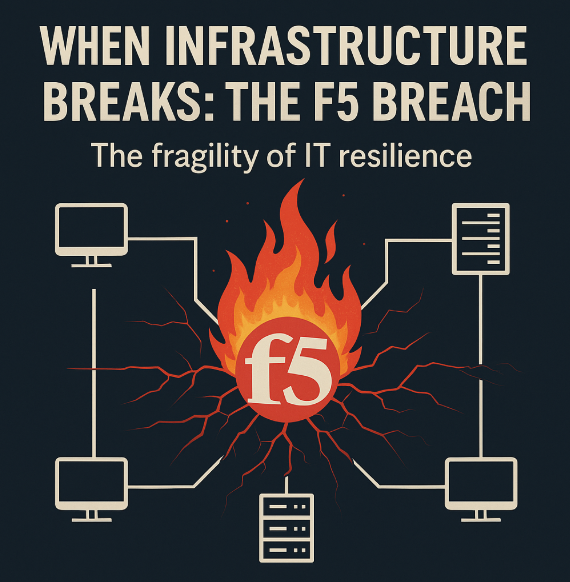
When F5 confirmed that a nation-state actor had infiltrated its internal systems and stolen parts of the BIG-IP source code and internal vulnerability data, it was easy to file it under “another day, another breach.” But that would be a mistake — a big one.
Because this isn’t just another cybersecurity story. It’s an IT infrastructure story — one that exposes the fragility at the heart of the systems we depend on to keep business, government and the internet itself running.
This breach, disclosed publicly by F5 in Security Advisory K000154696 and detailed by Tenable’s analysis, involved attackers stealing not only product source code but also information about unpatched vulnerabilities that F5 engineers were still triaging. That’s the equivalent of stealing the combination to the vault — along with a list of all the weak hinges and cracks in the door.
When the Foundation Cracks
To understand the significance, you have to appreciate where F5 sits in the digital ecosystem.
F5’s BIG-IP appliances and virtual editions handle load balancing, SSL termination, application delivery and network security for thousands of enterprises, service providers and government agencies. They are the unseen backbone behind many of the world’s most critical applications and data flows.
If you’ve ever logged into your bank account, streamed a show, or connected to a SaaS app hosted in a data center — odds are, an F5 product helped make that happen.
Now imagine the source code of those systems, plus details of unpatched vulnerabilities, sitting in the hands of a nation-state adversary. It’s not hard to see why CISA immediately issued Emergency Directive 26-01, requiring all federal agencies to inventory, patch and harden their F5 devices. When the people in charge of defending .gov networks say “drop everything and fix this,” you know it’s serious.
Beyond Cybersecurity: A Crisis of Infrastructure Trust
The F5 incident exposes a bigger truth that IT leaders have ignored for too long: We have built our infrastructure on monocultures.
The same way an agricultural monoculture can be wiped out by a single disease, an infrastructure monoculture can be crippled by a single exploit. If your enterprise routes 80% of its mission-critical traffic through one vendor’s technology, you’re not resilient — you’re fragile.
It’s easy to talk about “vendor consolidation” and “platform standardization” as efficiency plays. They save budget, reduce complexity and make training easier. But they also make your entire stack dependent on one company’s security hygiene, one code base, one supply chain and one set of internal controls.
When that vendor gets breached — and make no mistake, eventually someone always does — you inherit that risk instantly.
This isn’t theoretical. We’ve seen it before with SolarWinds, Kaseya, MOVEit and even Microsoft’s Storm-0558 compromise. Each time, we swear we’ve learned the lesson. And each time, market inertia pulls us right back to the same posture: Overreliance on the familiar.
A Wake-Up Call for CIOs and IT Leaders
Here’s the uncomfortable truth: This isn’t just a cybersecurity event; it’s an IT operations continuity issue of the highest order.
Let’s break down what CIOs, infrastructure heads and IT directors should take away from the F5 breach.
1. Redundancy Must Be Architectural, Not Just Hardware
You can buy all the redundant boxes you want, but if they all run the same code base, you haven’t achieved resilience — you’ve created replicated risk. True redundancy comes from architectural diversity: Different vendors, different stacks, even different security models where possible.
2. Patch Management is Now a Supply Chain Discipline
Too often, patching is treated as a tactical task. It’s not. It’s part of your software supply chain integrity. Enterprises should integrate patch verification into their ITSM pipelines, automate vulnerability scanning tied to SBOM data, and verify that updates are cryptographically signed and tracked end-to-end.
3. Transparency From Vendors Isn’t Optional
After SolarWinds, many vendors promised “secure development lifecycles.” Now’s the time to prove it. Infrastructure providers must be transparent about their internal security posture — not just the products they ship. That includes code repo security, build system integrity and insider threat controls.
4. Business Continuity Requires Scenario Planning
If your infrastructure team hasn’t gamed out a scenario where your primary vendor is offline, compromised, or embargoed, you’re already behind. Run tabletop exercises:
- What if F5 (or your equivalent) went down for 30 days?
- Could you reroute traffic?
- Could you switch providers, even temporarily?
The answers might be sobering — but they’re better discovered now than in the middle of a crisis.
The Human Side of the Equation
Let’s not forget that at the end of every infrastructure system are the humans who build, manage and maintain it. IT teams are stretched thin. They’re dealing with technical debt, tool sprawl, budget constraints and now — an adversary armed with insider-level knowledge of one of their core vendors.
This incident should also remind us of something fundamental: Security and IT ops are two sides of the same coin. You can’t run a secure infrastructure without operational excellence, and you can’t run a resilient infrastructure without secure foundations.
Shimmy’s Take
Let’s call this what it is: A five-alarm fire for IT infrastructure.
This breach isn’t just about stolen code — it’s about broken trust. It’s a vivid reminder that the reliability we take for granted is, in reality, built atop a fragile web of assumptions: That vendors are secure, that updates are safe, that code bases are clean, that no one’s watching from the shadows.
We’ve been lulled by the convenience of “single-vendor simplicity.” We talk about modernization, automation and AI-driven ops — but all that efficiency means nothing if your foundation can be compromised from the inside.
The lesson from F5 is simple: Resilience isn’t redundancy, it’s independence. It’s the ability to operate when your favorite platform, your trusted vendor, or your go-to product is suddenly part of the problem.
So yes, F5 will patch, rebuild and regain customer trust. But for the rest of us, the question lingers: How many other unseen dependencies are one breach away from shaking the digital world?
It’s time to find out — before someone else does it for us.


